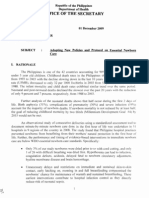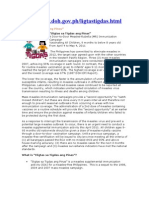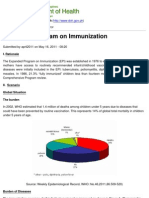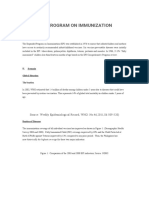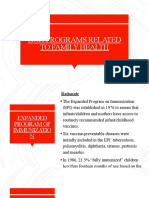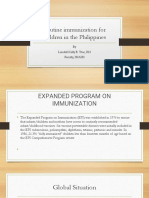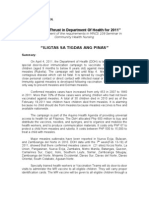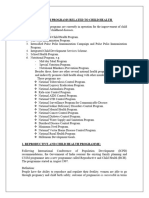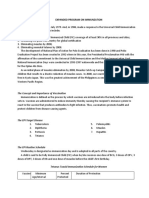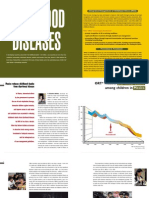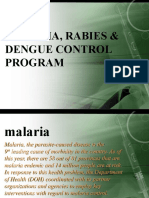Essential Newborn Care
Essential Newborn Care
Uploaded by
Patrick Ranier A. LatozaCopyright:
Available Formats
Essential Newborn Care
Essential Newborn Care
Uploaded by
Patrick Ranier A. LatozaCopyright
Available Formats
Share this document
Did you find this document useful?
Is this content inappropriate?
Copyright:
Available Formats
Essential Newborn Care
Essential Newborn Care
Uploaded by
Patrick Ranier A. LatozaCopyright:
Available Formats
Essential Newborn Care (ENC) TThe ENC Protocol is a step-by-step guide for health workers and medical practitioners
issued by the Department of Health for implementation under Administrative Order 2009-0025. What are these step-by-step interventions?
Immediate drying Using a clean, dry cloth, thoroughly dry the baby, wiping the face, eyes, head, front and back, arms and legs.
Uninterrupted skin-to-skin contact Aside from the warmth and immediate bonding between mother and child, it has been found that early skin-to-skin contact contributes to a host of medical benefits such as the overall success of breastfeeding/colostrum feeding, stimulation of the mucosaassociated lymphoid tissue system, and colonization with maternal skin flora that can protect the newborn from sepsis and other infectious disease and hypoglycemia.
Proper cord clamping and cutting Waiting for up three minutes or until the pulsations stop is found to reduce to chances of anemia in full term and pre-term babies. Evidence also shows that delaying cord clamping has no significant impact on the mother.
Non-separation of the newborn from the mother for early breastfeeding initiation and rooming-in The earlier the baby breastfeeds, the lesser the risk of death. Keeping the baby latched on to the mother will not only benefit the baby (see skin-to-skin contact) but will also prevent doing unnecessary procedures like putting the newborn on a cold surface for examination (thereby exposing the baby to hypothermia), administering glucose water or formula and foot printing (which increases risk of contamination from ink pads) and washing (the WHO standard is to delay washing up to 6 hours; the vernix protects the newborn from infection). On the other hand, necessary actions such as eye care, vitamin K administration must be timed. Eye care must be done after the infant has located the mothers breast. Unang Yakap Campaign In September 2000, the Philippines committed to the UN Millennium Declaration, targeting reduction of poverty, hunger and ill health in the country, including reduction of maternal, newborn and child mortality. The Philippines is currently "on track" to reach its Millennium Development Goal #4 target of reducing under-five mortality. However, some 40,000 Filipino newborns still die every year. Half of these newborns die in the first two days of life. Administrative Order 2009-0025 The current state of newborn care needs urgent action. To this end, the Department of Health has issued Administrative Order 2009-0025 which outlines specific policies and principles for health care providers with regard the prescribed systematic implementation of interventions that address health risks known to lead to preventable neonatal deaths. This AO is consistent with AO No. 2008-0029 on Implementing Health Reforms for Rapid Reduction of Maternal and Newborn Mortality and supports all DOH initiatives and programs for newborn and child health. Iligtas sa Tigdas ang Pinas Iligtas sa Tigdas ang Pinas A Door-to-Door Measles-Rubella (MR) Immunization Campaign Vaccinating All Children, 9 months to below 8 years old From April 4 to May 4, 2011 The Philippines has committed to eliminate measles in 2012, the target year agreed upon with the other countries in the Western Pacific Region. Three (3) mass measles immunization campaigns were conducted in 1998, 2004 and 2007, achieving 95% coverage in each round. In contrast, the annual coverage for routine measles vaccination given to infants ages 9-11 months never reached the target of at least 95%. The highest coverage ever attained is 92% and the lowest coverage was 67% (1987 DOH EPI Report). The lower the coverage, the faster is the accumulation of unimmunized susceptible infants, resulting in measles outbreaks in different areas of the Philippines. Laboratory confirmed measles cases continued to be reported all over the country, which indicates uninterrupted circulation of measles virus transmission resulting to illness and deaths among children. Mass measles immunization campaigns provide a second opportunity to catch missed children, but these are done every 2-3 years interval and therefore not enough to prevent seasonal outbreaks from occurring in areas with low immunization coverage.
The administration of a 2nd dose of measles containing vaccines on a routine schedule will provide this second opportunity at an earlier time and ensure the protection against measles of infants/children who failed to be protected during the first dose. As a response to interrupt the transmission of the measles virus and prevent a potential large measles outbreak to occur, there is an urgent need to conduct a measles supplemental immunization activity this April 2011. All children ages 9-95 months old nationwide should be given a dose of measles-rubella vaccine through a door-to-door vaccination campaign. Unlike previous campaign, a measles-free certification will be issued to city/province meeting all the criteria of (1) all barangays passed the RCA with no missed child and 95% and above house marking accuracy; (2) there are no measles cases for the next 3 months after the campaign and (3) measles surveillance indicators have met the national standards. What is Iligtas sa Tigdas ang Pinas? y Iligtas sa Tigdas ang Pinas is a measles supplemental immunization activity (SIA) for a measles-free Philippines. This is a sequel to the 1998, 2004 and 2007 mass measles campaign. What vaccination strategy will be used in this activity? y Strictly Door-to-Door immunization strategy What are the doors referred to in this campaign? y It includes all doors of houses, condominiums, apartments, tenements, orphanages and halfway homes as well as nonconventional doors in the community y Non-conventional doors include the following: 1. Informal settlements such as families/persons living under the bridge, inside the parks, cemeteries and open spaces; in tents, carts, abandoned buildings, old vehicles/trains/motorboats, under the trees, in islands on the middle of the street, etc. 2. All business/commercial establishments and market stall where children may reside 3. Institutions 4. Eligible children of mobile and roaming families with no houses or no permanent house shall be identifies and given immunization. y All eligible children found in the parks, playgrounds, streets, markets, and other public places shall be directed to go home to be vaccinated. y Areas like day care centers, schools, malls, groceries, or churches shall not be visited anymore (if and only if no family resides). How is this different from the previous campaign? Measles-free certification will be issued to provinces and cities if all the following criteria are met: y All barangays have passed the Rapid Coverage Assessment (RCA) with no missed child AND 95% house marking accuracy; and y There are no measles cases for the next 3 months after the campaign; and y Measles surveillance indicators have met the national standard: 1. At least 80% of surveillance sites should report each week on the presence or absence of suspected measles cases. 2. At least 80% of the reported suspected cases should be reported within 48 hours of rash onset. 3. At least 80% of the reported suspected cases should be investigated within 48 hours of report. 4. At least 80% of specimens should be taken from initial contact until 28 days post rash onset and reach the laboratory in a suitable state for testing. 5. At least 80% of specimens must be tested and the results reported back to the surveillance unit within 7 days of receipt of the specimen in the laboratory. The certification process will be conducted at the end of the campaign.
You might also like
- CHN DOH ProgramsDocument158 pagesCHN DOH Programsjudd wilson100% (2)
- Clothes - Traditional Clothing Around The WorldDocument3 pagesClothes - Traditional Clothing Around The WorldEnikő HorváthNo ratings yet
- Millions Saved: New Cases of Proven Success in Global HealthFrom EverandMillions Saved: New Cases of Proven Success in Global HealthRating: 5 out of 5 stars5/5 (1)
- Institutional Markets and Government Markets and How Institutional and Government Buyers Make Their Buying DecisionsDocument5 pagesInstitutional Markets and Government Markets and How Institutional and Government Buyers Make Their Buying DecisionsHasan Afaque80% (5)
- AO 2009 0025 Essential Newborn CareDocument15 pagesAO 2009 0025 Essential Newborn Carejulesubayubay542895% (21)
- Unang Yakap FlyerDocument2 pagesUnang Yakap FlyerKeith Giomeer Petrola83% (6)
- Epi PowerpointDocument29 pagesEpi PowerpointFelisa Lacsamana Gregorio100% (4)
- Automechanika 2017 CatalogueDocument202 pagesAutomechanika 2017 CatalogueAlex Renne ChambiNo ratings yet
- HTTPDocument3 pagesHTTPdahellisaNo ratings yet
- Dept. Expanded Program On ImmunizationDocument6 pagesDept. Expanded Program On ImmunizationknotstmNo ratings yet
- Department of Health - Expanded Program On Immunization - 2012-05-16Document7 pagesDepartment of Health - Expanded Program On Immunization - 2012-05-16MasterclassNo ratings yet
- Expanded Program On ImmunizationDocument4 pagesExpanded Program On ImmunizationKrizle AdazaNo ratings yet
- Expanded Program On ImmunizationDocument6 pagesExpanded Program On ImmunizationAiza Oronce100% (1)
- CHN Lecture Module 7 Doh Programs Related To Family HealthDocument42 pagesCHN Lecture Module 7 Doh Programs Related To Family HealthMhianne SarmientoNo ratings yet
- CHN Lecture Module 7 Doh Programs Related To Family HealthDocument41 pagesCHN Lecture Module 7 Doh Programs Related To Family HealthALLAN KARL N. YNGENTENo ratings yet
- Doh ProgramsDocument8 pagesDoh ProgramsClara CentineoNo ratings yet
- E Inc PoliciesDocument2 pagesE Inc PoliciesricogeminaNo ratings yet
- Doh ProgramsDocument14 pagesDoh ProgramsSweetyfe GabatanNo ratings yet
- Expanded Program On Immunization: Source: Weekly Epidemiological Record, WHO: No.46,2011,86.509-520)Document6 pagesExpanded Program On Immunization: Source: Weekly Epidemiological Record, WHO: No.46,2011,86.509-520)Abeer AguamNo ratings yet
- Expanded Program On Immunization: Source: Weekly Epidemiological Record, WHO: No.46,2011,86.509-520)Document6 pagesExpanded Program On Immunization: Source: Weekly Epidemiological Record, WHO: No.46,2011,86.509-520)Abeer AguamNo ratings yet
- Doh Programs Related To Family HealthDocument31 pagesDoh Programs Related To Family Healthamal abdulrahmanNo ratings yet
- DOH Programs Related To Family Health - SLIDESDocument160 pagesDOH Programs Related To Family Health - SLIDESKevin Villarante100% (1)
- Self Directive LearningDocument18 pagesSelf Directive Learningcrystal fate valdezNo ratings yet
- Routine Immunization For Children in The Philippines-1Document17 pagesRoutine Immunization For Children in The Philippines-1Clari DelgadoNo ratings yet
- Doh ThrustDocument3 pagesDoh ThrustJei SonNo ratings yet
- A Study On Evaluation of Factors Affecting Child ImmunizationDocument53 pagesA Study On Evaluation of Factors Affecting Child ImmunizationAbhishek JaluthriaNo ratings yet
- Health Ministry Urges Parents To Have Children VaccinatedDocument30 pagesHealth Ministry Urges Parents To Have Children VaccinatedBritanya EastNo ratings yet
- Breastfeeding TSEKDocument23 pagesBreastfeeding TSEKnicapot88No ratings yet
- ThursdayDocument5 pagesThursdayKateleen BaldoradoNo ratings yet
- Child Health and Development Strategic Plan Year 2001Document5 pagesChild Health and Development Strategic Plan Year 2001Piao Liang JingNo ratings yet
- Expanded Program On ImmunizationDocument7 pagesExpanded Program On ImmunizationVanessa Abboud100% (1)
- Limination F Etanus: Supervised By: Dr-Dalia El-DeebDocument7 pagesLimination F Etanus: Supervised By: Dr-Dalia El-DeebBahaa ShaabanNo ratings yet
- National Health Programs Related To Child HealthDocument22 pagesNational Health Programs Related To Child HealthdarsaimarasheedNo ratings yet
- Essential Intrapartum and Newborn Care (EINC) Bulletin 1Document10 pagesEssential Intrapartum and Newborn Care (EINC) Bulletin 1maxicap7386% (7)
- Immediate Newborn CareDocument8 pagesImmediate Newborn Caree jeighNo ratings yet
- Expanded Program ImmunizationDocument4 pagesExpanded Program ImmunizationLheiDanielMariellMonteroNo ratings yet
- Health PoliciesDocument5 pagesHealth PoliciesWarren LadrillonoNo ratings yet
- Doh ProgramsDocument7 pagesDoh ProgramsFatima Grace EchemNo ratings yet
- Expanded Program On Immunzation: The Concept and Importance of VaccinationDocument4 pagesExpanded Program On Immunzation: The Concept and Importance of VaccinationrockmitrillNo ratings yet
- Essential Newborn CareDocument14 pagesEssential Newborn CareJhing Rodriguez BorjalNo ratings yet
- Department of Infectious Diseases Vaccination in India: - Rajkumar Subasaravanan Subgroup "12"Document88 pagesDepartment of Infectious Diseases Vaccination in India: - Rajkumar Subasaravanan Subgroup "12"Suba Saravanan 12100% (2)
- Childhood Diseases: Integrated Management of Childhood Illness (IMCI)Document13 pagesChildhood Diseases: Integrated Management of Childhood Illness (IMCI)Zinash FikireNo ratings yet
- National GoalsDocument19 pagesNational GoalsdarsaimarasheedNo ratings yet
- Expanded Immunization PorgramDocument6 pagesExpanded Immunization PorgramJavie Bryant RedilNo ratings yet
- National Health Programmes For Children in IndiaDocument79 pagesNational Health Programmes For Children in IndiashahnazNo ratings yet
- EPI ManualDocument73 pagesEPI ManualRich Arocena100% (1)
- Local Media3061431616755544477Document42 pagesLocal Media3061431616755544477Kim Harold SalasNo ratings yet
- Malaria Rabies DHFDocument57 pagesMalaria Rabies DHFapril lacsonNo ratings yet
- Unang YakapDocument2 pagesUnang Yakapzyawo_04No ratings yet
- Essential Newborn Care PowerpointDocument35 pagesEssential Newborn Care PowerpointKrystal Tan100% (2)
- Pulse PolioDocument99 pagesPulse PolioChulbul Pandey100% (1)
- Community Health Nursing (Learning Feedback Diary (LFD #25)Document3 pagesCommunity Health Nursing (Learning Feedback Diary (LFD #25)Angelica Malacay RevilNo ratings yet
- Childhood Obesity: Causes and Consequences, Prevention and Management.From EverandChildhood Obesity: Causes and Consequences, Prevention and Management.No ratings yet
- Care For Vulnerable Populations During COVID-19 PandemicFrom EverandCare For Vulnerable Populations During COVID-19 PandemicNo ratings yet
- Safe and Clean Care: Infection Prevention and Control for Health and Social Care StudentsFrom EverandSafe and Clean Care: Infection Prevention and Control for Health and Social Care StudentsNo ratings yet
- Vaccines: Does herd immunity justify permanent impairment for a few?From EverandVaccines: Does herd immunity justify permanent impairment for a few?No ratings yet
- Care For Vulnerable Populations during COVID-19 Pandemic: Clinical Updates in COVID-19From EverandCare For Vulnerable Populations during COVID-19 Pandemic: Clinical Updates in COVID-19No ratings yet
- China's Novel Coronavirus Response: Guidelines for Governments, Communities, Entities and Individuals to Combat COVID-19From EverandChina's Novel Coronavirus Response: Guidelines for Governments, Communities, Entities and Individuals to Combat COVID-19No ratings yet
- Challenges Faced by Women Single Parents in NigeriaDocument6 pagesChallenges Faced by Women Single Parents in NigeriaAsiyatu AbubakarNo ratings yet
- DA203 C1 Rev 10Document1,290 pagesDA203 C1 Rev 10nikkon1No ratings yet
- Cambridge International Advanced Subsidiary and Advanced LevelDocument4 pagesCambridge International Advanced Subsidiary and Advanced LevelLara BrownNo ratings yet
- Prezentacja CanadaDocument13 pagesPrezentacja CanadaEdiNo ratings yet
- DR Arlene's Leadership StoryDocument5 pagesDR Arlene's Leadership StoryGil OrenseNo ratings yet
- Pi (E) Day Payday!: Marketing Lead: Sam DomingoDocument4 pagesPi (E) Day Payday!: Marketing Lead: Sam DomingoYuan TugnaoNo ratings yet
- Amal SamsungDocument13 pagesAmal SamsungAboubakr SoultanNo ratings yet
- Self-Liquidating Inventory Loan: Rose - Chapter 17 #1Document37 pagesSelf-Liquidating Inventory Loan: Rose - Chapter 17 #1Lê Chấn PhongNo ratings yet
- Current Affairs Mcqs File 1 Updated One Paper MCQs PreparationDocument30 pagesCurrent Affairs Mcqs File 1 Updated One Paper MCQs PreparationNadir Ali BalochNo ratings yet
- Fiji Pays Off 1st Global BondDocument48 pagesFiji Pays Off 1st Global BondfijitimescanadaNo ratings yet
- Taize Prayer Guide Imus 21 August 2018Document2 pagesTaize Prayer Guide Imus 21 August 2018Ferdinand Leo MendozaNo ratings yet
- Test Answers For English Spelling Test (U.S. Version) 2015Document18 pagesTest Answers For English Spelling Test (U.S. Version) 2015Anas RiazNo ratings yet
- Kinatac An Vs DecenaDocument12 pagesKinatac An Vs DecenaNoreenL.Natingor-TabanaoNo ratings yet
- 50 Things That Millionaires Do - Xxxx-11111Document22 pages50 Things That Millionaires Do - Xxxx-11111isakabu100% (2)
- IFRS 16 Example: Initial Measurement of The Right-Of-Use Asset and Lease Liability (Quarterly Payments)Document4 pagesIFRS 16 Example: Initial Measurement of The Right-Of-Use Asset and Lease Liability (Quarterly Payments)Ankit ShahNo ratings yet
- Super Secret Crisis War!: Cow & Chicken #1 PreviewDocument7 pagesSuper Secret Crisis War!: Cow & Chicken #1 PreviewGraphic Policy100% (1)
- Medicines Policy 81 PDFDocument48 pagesMedicines Policy 81 PDFPaulo'RodriguesNo ratings yet
- CH 8 Island Biogeography LabDocument2 pagesCH 8 Island Biogeography LabSantiago HighNo ratings yet
- Licensed Agents 2017.Document8 pagesLicensed Agents 2017.URAugandaNo ratings yet
- ProofDocument1 pageProofxhxbxbxbbx79No ratings yet
- MR Ratan 1Document5 pagesMR Ratan 1Nisha AggarwalNo ratings yet
- Pakistan Airport Passenger DataDocument4 pagesPakistan Airport Passenger DataRajesh BhaskaranNo ratings yet
- IT Audit ChecklistDocument40 pagesIT Audit ChecklistPatricia Zhonga100% (6)
- Public Administration Unit-98 Administrative Problems of Public SectorDocument11 pagesPublic Administration Unit-98 Administrative Problems of Public SectorDeepika SharmaNo ratings yet
- Bahasa InggrisDocument3 pagesBahasa InggrisFadia Rahmah AshariNo ratings yet
- Young Franklin: Lesson Answer KeyDocument2 pagesYoung Franklin: Lesson Answer KeyKaelon Gilland-EvansNo ratings yet
- New Detective WorkDocument2 pagesNew Detective Work10131No ratings yet




